Civil society spotlight reports
Civil society reports, or spotlight reports, serve as an important mechanism for holding national governments accountable for making progress on their commitments
While the Voluntary National Review (VNR) process is the primary channel for reporting on country-level progress on the SDGs and the 2030 Agenda, civil society reports are vital to ensuring an independent, robust and accurate assessment of progress within countries, and provide a direct means to promote this government accountability to its citizens. They can complement or call into question States’ official reports and also provide an avenue for civil society voices to be heard on national and international stages—thereby showcasing the value of civil society engagement in SDG implementation and monitoring.
Independent, public scrutiny by civil society has the potential to make sure that governments’ reports of national-level implementation of the 2030 Agenda are accurate when they are provided for regional and global monitoring processes. CSOs’ reports also can provide key findings and make recommendations for SDG implementation at the national level.
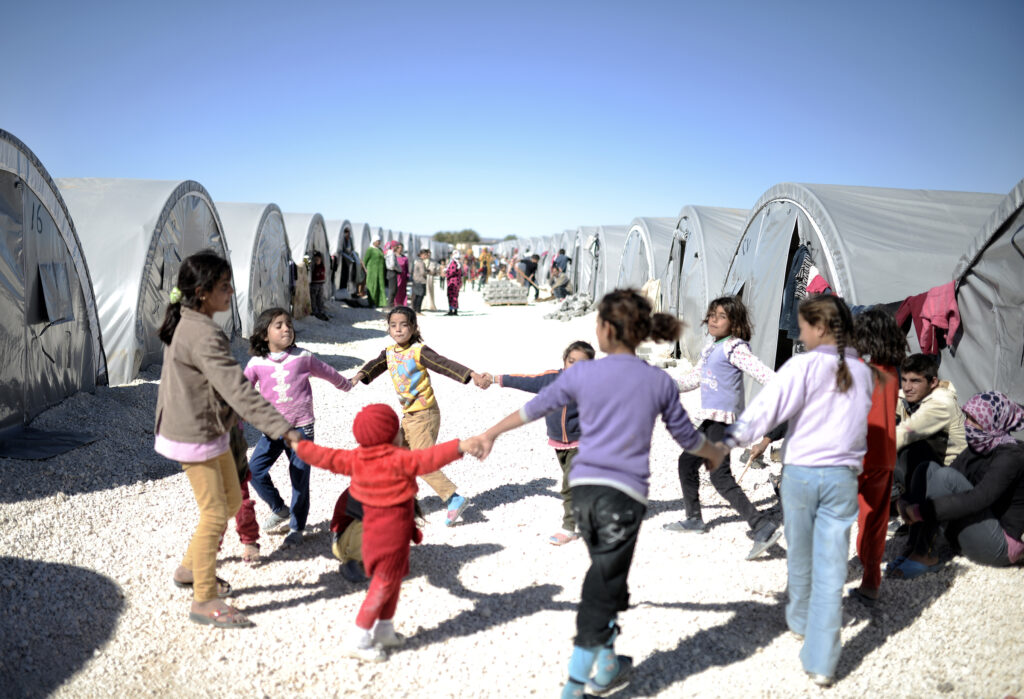
Meaningful civil society participation in encouraging inclusive and open SDG implementation, follow-up and review and accountability is critical to ensuring that governments are responsive to the demonstrated needs of the diverse segments of each society. In many ways, civil society stakeholders serve as the most indispensable part of the measurement, monitoring and accountability framework for the SDGs, as they often provide a critical link between governments and stakeholders. Nationally and locally-focused civil society stakeholders can therefore play a key role in monitoring and reviewing processes at the national level.[1]
Furthermore, providing civil society reports is just one of the many ways that civil society can continue to build a positive working relationship with governments in support of the SDGs by building trust and rapport so that governments see civil society as partners to be engaged in achieving shared goals.[2]
Civil society reporting represents an unofficial mechanism for monitoring and holding governments accountable on SDG implementation. As such, the processes for creating and utilizing these reports are not formalized in the same way as official, government-led reporting. Given this reality, it is critical for CSOs to take care in determining whether civil society reporting is the most effective accountability mechanism to use in monitoring SDG implementation and, if so, to ensure that their reports are properly prepared and disseminated for maximum impact.[1]
Is the context right for a civil society report?
Prior to beginning the reporting process it is essential to understand the political climate for reporting. CSOs thinking of creating SDG reports should be mindful of the political climate in their respective home countries—specifically taking into account the risks of such monitoring and accountability efforts. Before undertaking reporting efforts, CSOs must consider if the environment is safe by asking questions like, “How does my government respond to criticism?” or “What are the national laws in my country concerning freedom of speech?”
While it is important to hold national governments accountable to international norms, it is also necessary that CSOs pursue such actions in safe spaces, using regional and international forums or partners if independent reporting within a country is too risky. They should also determine whether an enabling environment for drafting an impactful report exists. If the purpose of drafting a SDG civil society report is to encourage a national government in action, then it is key to assess the likelihood that such work will bring about change, before investing in producing a report.[2]
1. Preparation: Identifying partners, funding and project plans
2. Adapting to Context
3. Outreach and Consultations
4. Report Development
5. Production and Dissemination
The following section provides an outline for any civil society stakeholder to use when putting together a civil society report on SDG implementation in your country. Additionally, you will find more detailed guidance on how to approach drafting each section of this report, including some key questions to consider answering and other relevant information you might find useful in this drafting process.
INTRODUCTION
● Executive Summary
● Background Context
● Process: Data & Methodology
CONTENT
a. Review of Legal and Legislative Framework and Policies
i. Brief introduction
ii. Assessment of frameworks
iii. Challenges and recommendations
b. Review of Country-level Implementation
i. Brief introduction
ii. Assessment of progress
iii. Challenges and recommendations
c. Review of International Commitments (if applicable)
i. Assessment of progress
ii. Challenges and recommendations
d. Civil Society Participation in SDG Implementation / Follow-up
i. Assessment of civil society space around the SDGs (and in general)
ii. Challenges and recommendations
CONCLUSION
● Conclusion
● Recommendations
ANNEXES
● List of Organizations Consulted
● Data Sets
● National Development Plans or Frameworks
● Other Sources (if applicable)
Approaches and Methodologies for Civil Society Reporting on the SDGs and 2030 Agenda (2021)
While there is no one-size-fits all approach to producing Spotlight reports, this resource from the TAP Network provides practical guidance on methodologies to consider when drafting an SDG Spotlight Report. Additionally, it provides a suggested template that organizations could use for their report, with specific tips for each chapter and approach, as well as key questions to consider when drafting the content of your report.
For more guidance on spotlight reporting, please see TAP’s updated Spotlight Reporting Guidelines resource: https://tapnetwork2030.org/sdg16reporting/
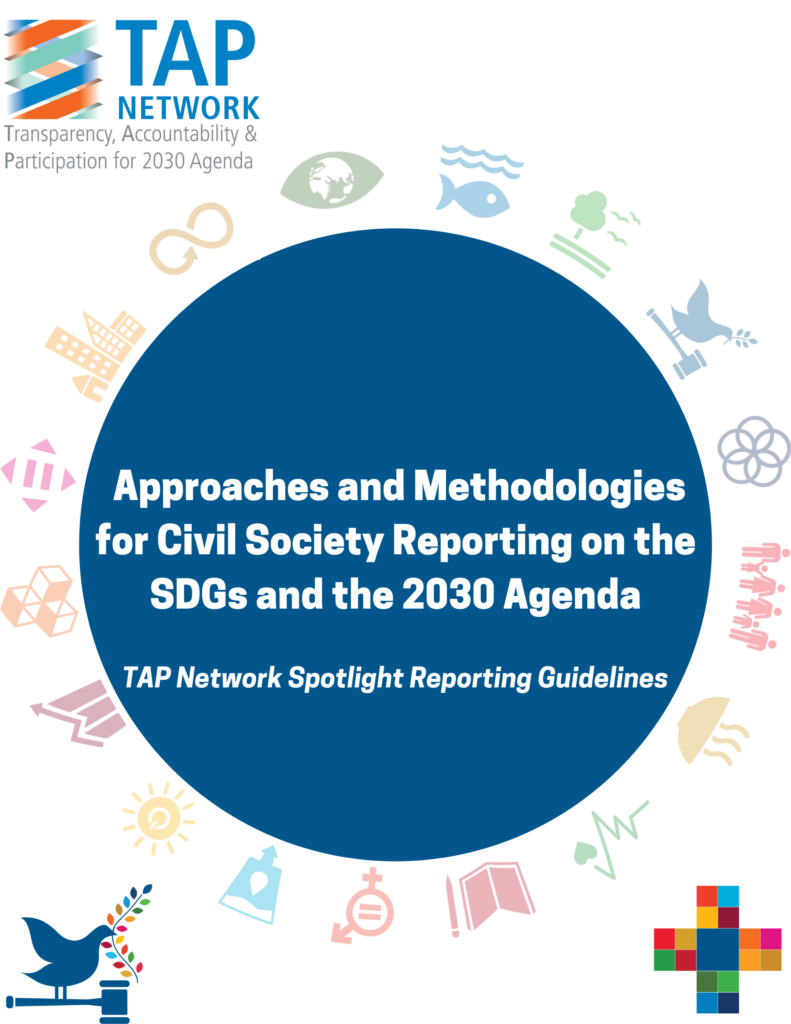
Case Study


Case Study
Assessing the Right to Information (SDG Indicator 16.10.2) in Canada
Centre for Law and Democracy
In 2020, the Centre for Law and Democracy in Canada performed an assessment of Canada’s implementation of the right to information. The project assessed three areas of implementation: proactive disclosure, institutional measures and responding to requests. The assessment identified several weaknesses in applying the letter of law and provisioning accessible and straightforward services to provide information. The methodology was applied in two other countries in 2020, Pakistan and Ukraine, and can serve as a critical tool in identifying gaps and achieving full implementation of SDG indicator 16.10.2 in countries.
The Freedom of Information Advocates Network (FOIANet), a civil society coalition focused the right to information, created a methodology to assess a country’s implementation of right to information. The methodology was applied by civil society actors in the three countries: the Centre for Law and Democracy in Canada, the Centre for Peace and Development Initiatives in Pakistan and UNDP in Ukraine.
The methodology involves selecting a group of five or more public authorities and assessing them on each area of implementation. The first two areas – proactive disclosure and institutional measures – are assessed through desk research. The third area – responding to requests – is assessed through action-oriented research: one to three requests are sent to each authority, and their response is assessed.
The Centre for Law and Democracy’s assessment of Canada’s implementation of the right to information found that a few categories of proactive disclosure in the core institutional information are consistently lacking, including the publishing of organizational structures, procurement processes and contact information for key contacts. Even when these types of information were published, they were often hidden in rather inaccessible places. The assessment resulted in the following key recommendations:
Key Take-away: Commitments of countries to achieve SDG indicator 16.10.2 and fulfill the right to information must be strengthened and accelerated, even in the most developed countries. Independent or civil society-organized assessments can be extremely valuable in highlighting weaknesses of institutions, defining the need for reform and change and increasing accountability.
Case Study


Case Study
Spotlight Reporting Methodology for Tracking Progress on Corruption Elimination
Transparency International – spotlight reports of governments’ progress towards SDG targets 16.4, 16.5, 16.6 and 16.10
In 2017, Transparency International (TI) developed a common methodology to enable civil society organizations to track their countries’ progress towards four SDG 16 targets especially relevant for anti-corruption, namely target 16.4 on illicit financial flows, target 16.5 on corruption and bribery, target 16.6 on accountable and transparent institutions and target 16.10 on access to information and fundamental freedoms. Since then, over 45 of TI’s national chapters have used the tool to produce spotlight reports that provide independent appraisals of governments’ anti-corruption efforts, which are essential to improve implementation of the 2030 Agenda across all SDGs.
Recognizing the lack of available data for the official SDG 16 indicators, TI’s methodology intentionally deviates from official indicator set, drawing on a wider range of alternative data sources to scrutinize the often uncritical assessments of national progress presented in VNRs. By going beyond the narrow understanding of corruption captured by the official global indicators, TI’s spotlight reports provide a more holistic assessment of the underlying conditions and drivers of corruption at national level.
The overall goal was to produce evidence to supplement the official government reports submitted as part of the VNR process. Looking at both the quality of the legislative and institutional framework and its actual implementation, the tool is designed to enable chapters and other national stakeholders to develop actionable recommendations across a range of relevant policy areas, from anti-money laundering to whistleblowing. In this way, the approach seeks to embed cyclical VNR reporting into a longer process of iterative reform, by generating data that can feed into governmental SDG reporting processes in each country.
The use of interviews proved to be a useful means of verifying findings from desk research. Moreover, establishing a working rapport with interviewees in government also subsequently provided chapters with “entry points” to key institutions when it came to the dissemination of findings and advocating for the adoption of policy recommendations. However, given that the primary purpose of spotlight reports is to scrutinize government performance, there remains a need for critical distance, and researchers need to be somewhat skeptical of their interlocutors’ assertions.
Key Take-aways: Civil society organizations are valuable providers and producers of actionable data that can help government to remedy vulnerabilities in a country’s anti-corruption framework.
Approaches and Methodologies for Civil Society Reporting on the SDGs and 2030 Agenda (TAP Network, updated 2021)
Recently updated guidance by the TAP Network provides an outline template for a civil society report and guiding questions to consider answering during the crafting process. Available at: http://tapnetwork2030.org/civilsocietyreporting/
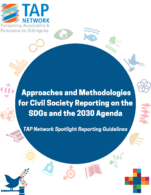
Empowering Civil Society for National Reporting and Action on SDG16 (TAP Network, 2018)
This report features a compilation of national civil society case studies and civil society spotlight reports on SDG 16. It provides analysis of a range of approaches and methodologies utilized by civil society for implementation and monitoring of SDG 16 by civil society, specifically with regards to drafting and disseminating of spotlight reports. Available at: https://tapnetwork2030.org/empowermentreport/
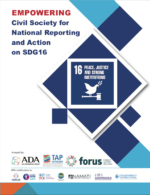
SDG Accountability Handbook: A Practical Guide for Civil Society (TAP Network, 2018)
This handbook provides guidance on the different approaches and steps that can be taken by civil society to ensure national government accountability for the SDGs. It includes a chapter on ‘Publishing Civil Society Reports.’ Available at: https://sdgaccountability.org/
https://sdgaccountability.org/working-with-informal-processes/spotlightreporting/
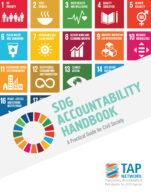
SDG16 in VNRs and Spotlight Reports: Reporting on Progress, Reflecting on Inclusive Accountability Measures and Recommendations for going ahead (GIZ and TAP Network, 2020)
This report evaluates VNR and spotlight reports submitted to the 2019 HLPF for a select group of countries. It examines whether and how spotlight and VNR reports relate to one another and identifies the main commonalities and differences between the perspectives of governments and civil society. Available at: https://tapnetwork2030.org/wp-content/uploads/2020/05/GIZ_TAP_2020_SDG-16-in-VNRs-and-Spotlight-Reports_Final-Version.pdf
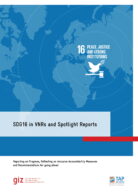
TAP Spotlight Reporting Platform
‘Share Your Civil Society Spotlight Report,’ by the TAP Network, is an online platform to collect and showcase spotlight reports from civil society stakeholders.
Available at: https://tapnetwork2030.org/sdg16reporting/

A flowchart guides peacebuilding actors through a series of key steps. The flowchart points you towards how to develop an advocacy plan on SDGs, where to find the governmental SDG focal point in your country, how to influence key actors on SDG16+ implementation and how to write a “SDG16+ shadow report.”
Available at: https://gppac.net/sdg16-toolkit
Practical guidance, drafting outline and tips to help craft a spotlight report on SDG 16. Includes a specific step-by-step process.
Available at: https://www.saferworld.org.uk/resources/publications/1201-enhancing-accountability-for-peaceful-just-and-inclusive-societies-practical-guidance-for-civil-society-reporting-on-sdg16?utm_source=smartmail&utm_medium=email&utm_campaign=Reporting+on+SDG16%2B%3A+a+practical+guide
Action for Sustainable Development’s HLPF 2018 Civil Society Report Template helps national CSOs consider how governments are involving civil society in their official implementation and review of the SDGs, and provides questions around the issue of leaving no one behind.
Available at: https://action4sd.org/wp-content/uploads/2018/07/HLPF-VNR_CSO-Report-Template_2018.pdf
Monitoring the Implementation of Agenda 2030 at the National Level (2018), by Forus International, includes examples of civil society reports and key steps to follow when preparing and producing a civil society SDG report.
Available at: http://forus-international.org/en/resources/8
This is a technical paper written for the Division for Sustainable Development, UN DESA.
Available at: https://sustainabledevelopment.un.org/content/documents/18445CSOreporting_paper_revisions_4May.pdf
The purpose of this research tool is to enable civil society organizations to conduct an independent appraisal of their respective country’s progress in fighting corruption, tackling illicit financial flows and improving transparency and access to information, as national governments implement the Agenda 2030.
Transparency International has launched a platform for CSOs and partners to publish and share their spotlight reports:
Available at: https://sdg16.transparency.org/
Transparency, Accountability &
Participation (TAP) Network
Address: 205 E 42nd St.
New York, NY 10017
Email:
secretariat@tapnetwork2030.org